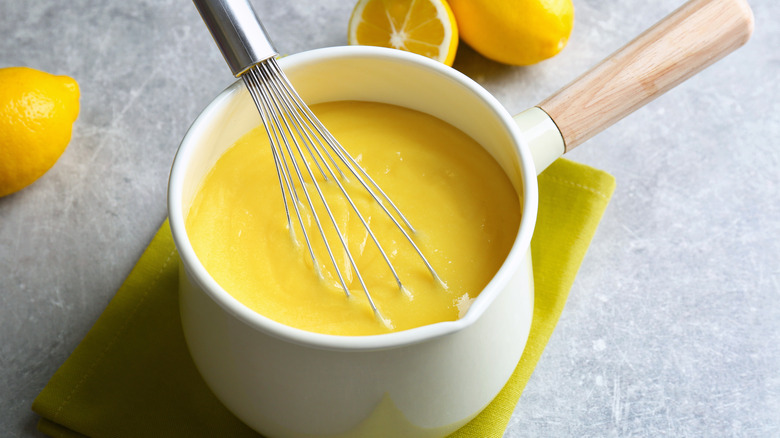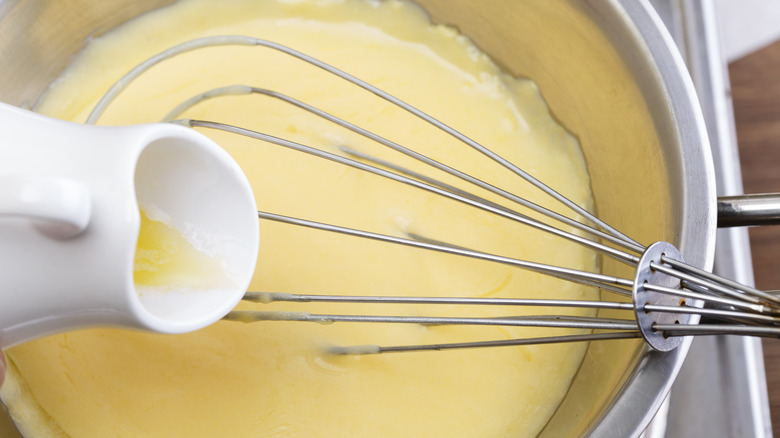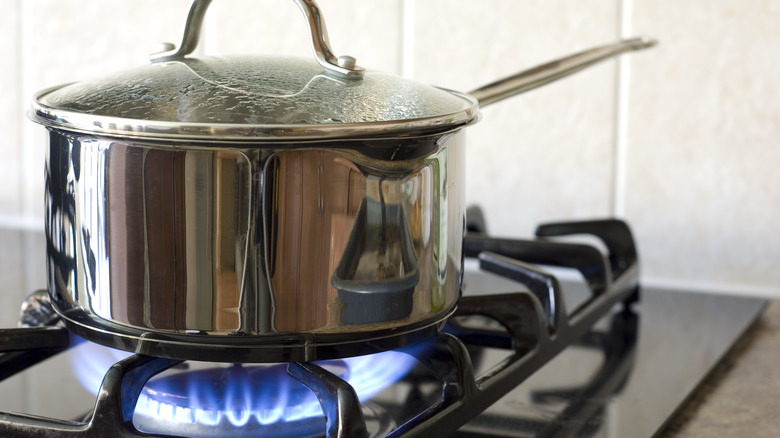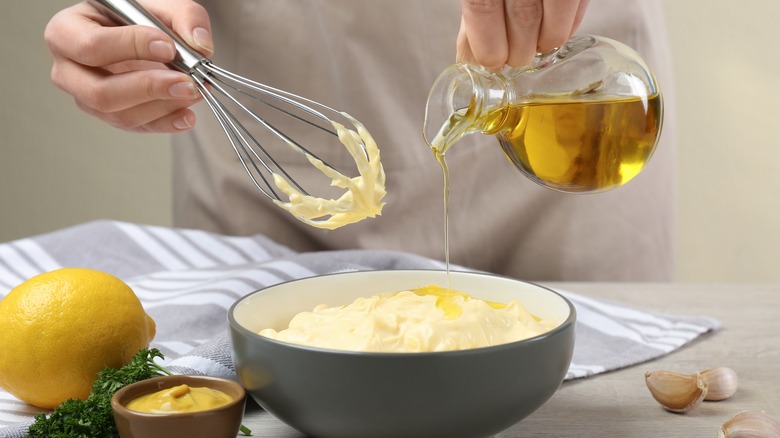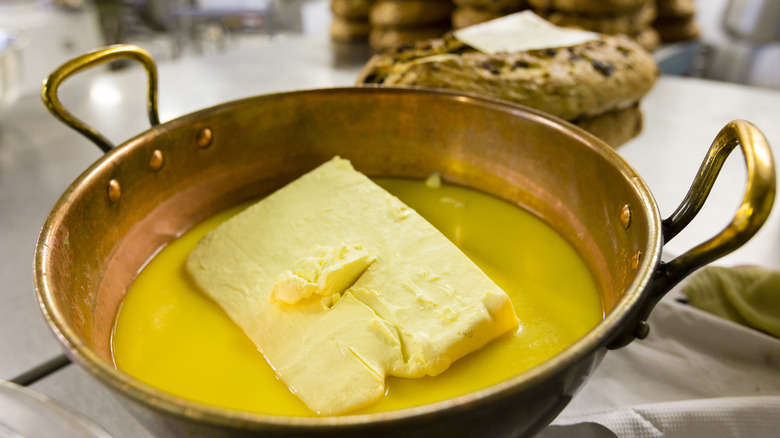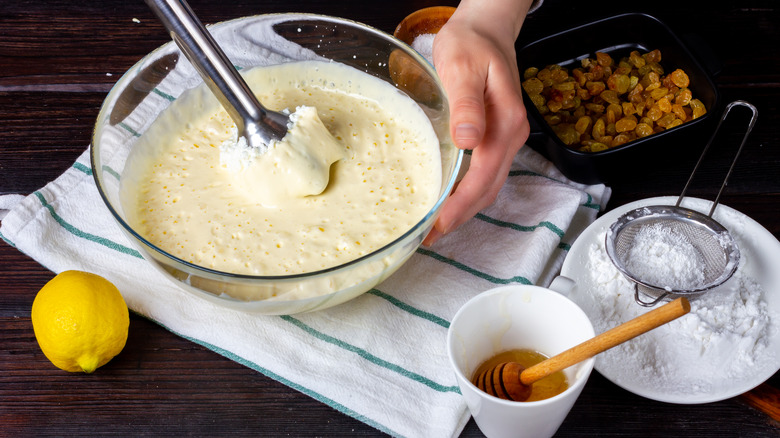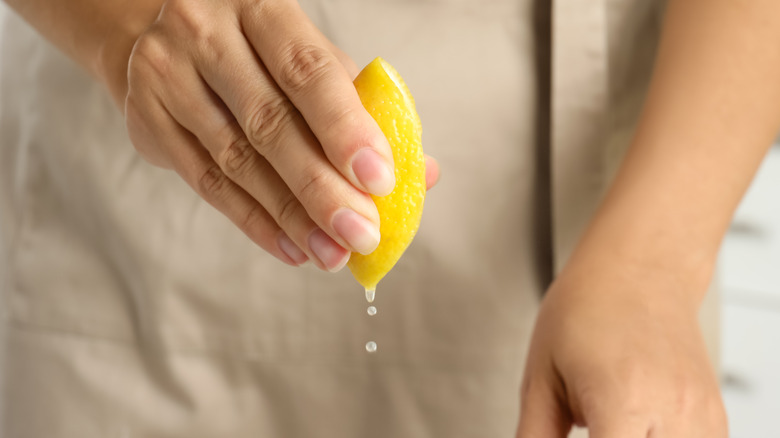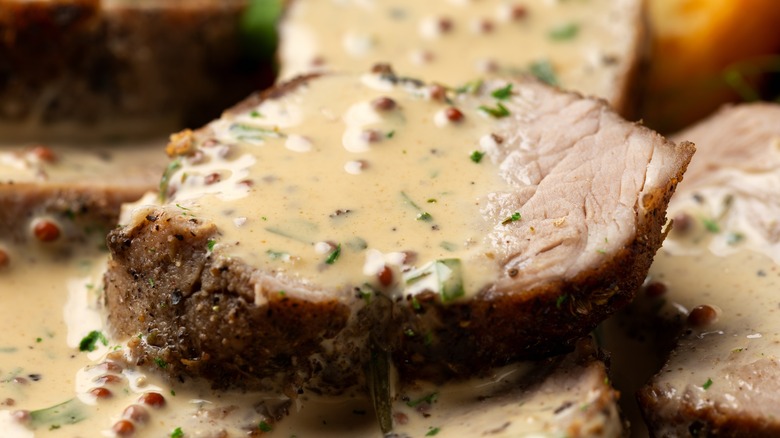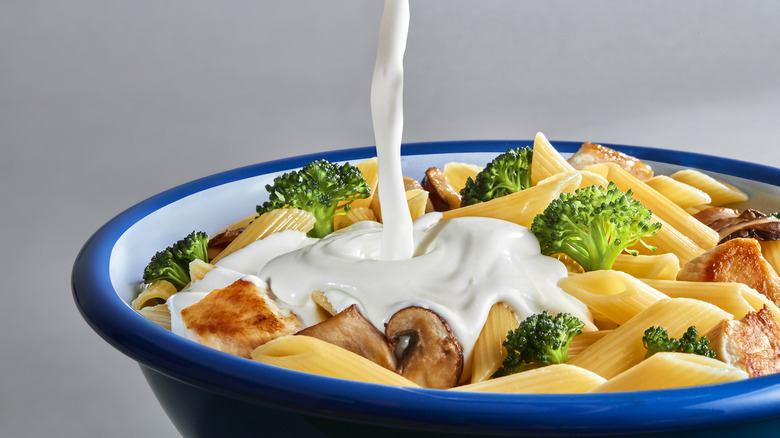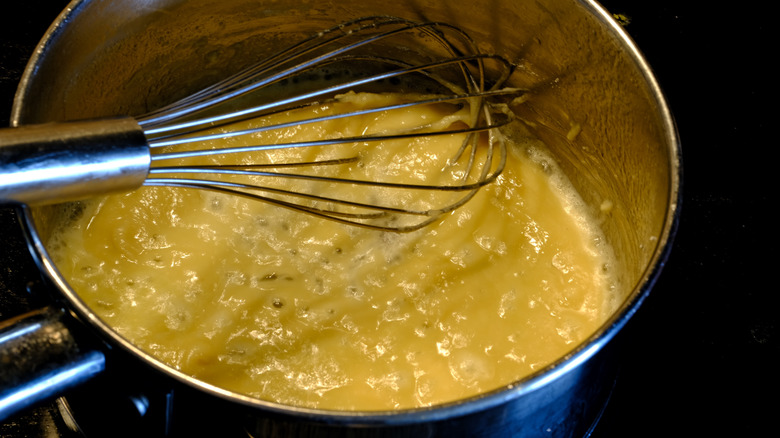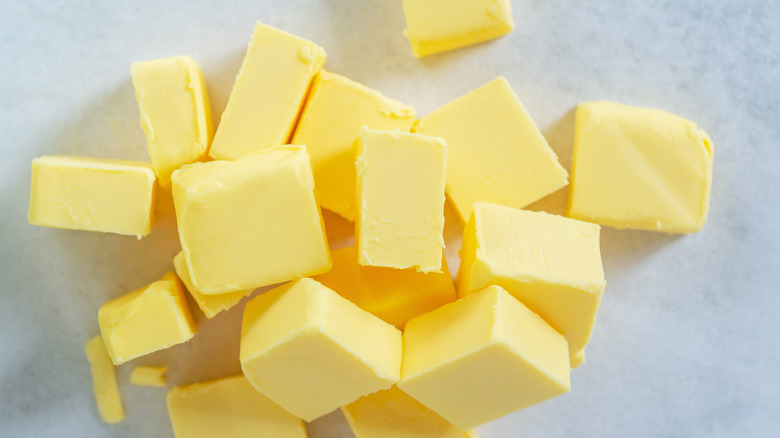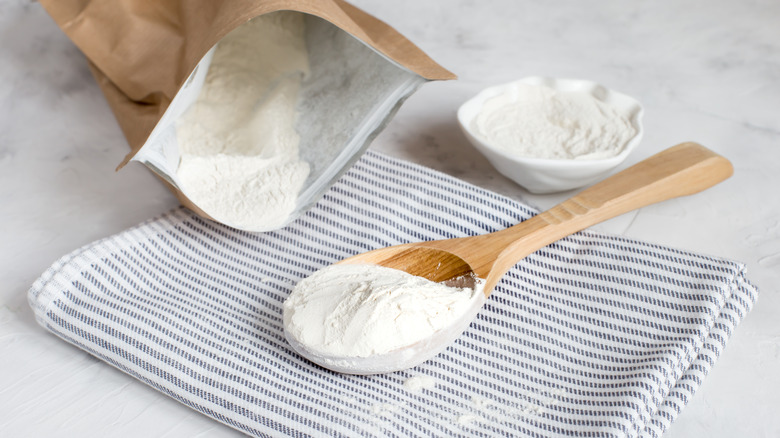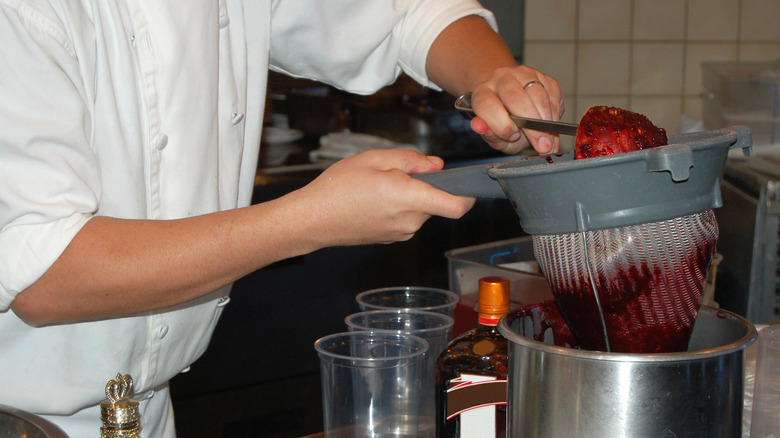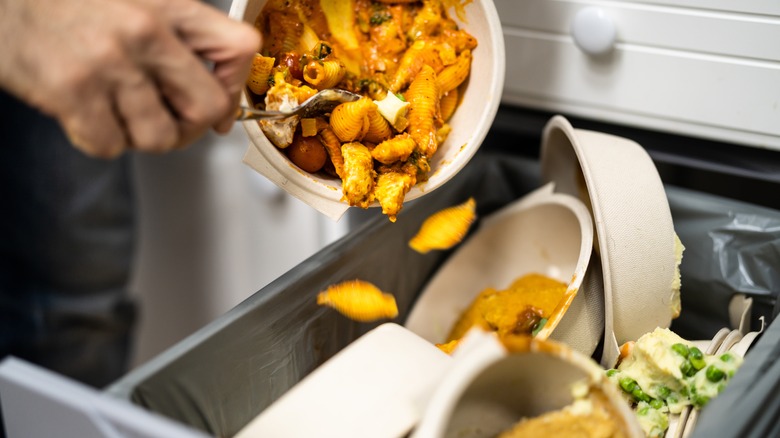13 Ways To Prevent And Fix Broken Sauce
We may receive a commission on purchases made from links.
Sauces are one of the essential foundations of all cooking. Most culinary schools have entire courses dedicated to the subject, covering everything from French demi-glace to Argentinian chimichurri recipes. Many home cooks shy away from sauce creation, preferring to leave it to the professionals because of tricky nuances in chemistry and technique. The truth is that while some sauces are straightforward, many involve a delicate balance of fat and water called an emulsion. When this emulsion fails to keep the two elements in suspension, we refer to the sauce as "broken."
Most times, a broken sauce is visually apparent immediately. It can manifest as small fat bubbles emerging suspended on the edges of your pan as you cook. Other times, it comes as the sauce settles, separating it into individual layers of fat, oil, or other liquids. In either case, the sauce is edible, but the texture will be completely off and sometimes downright disgusting. If making sauce is an important skill to have at home, knowing how to prevent or fix a broken sauce is crucial. In this guide, we will cover some of the common reasons sauces break in the first place and how to correct it or prevent it from happening in the first place.
Types of sauce and why they break
In order to understand why a sauce is broken and how to remedy it, we must first identify what type of emulsion or sauce it is. Egg-based emulsions, such as hollandaise, mayonnaise (or aioli), and even certain vinaigrettes like Caesar salad dressing, involve a suspension of fat (either oil or melted butter) and water, using eggs as an emulsification agent. If you vigorously shake just oil and vinegar together, it will be emulsified for a short time, and this is known as a temporary emulsion.
Making a sauce often requires you to utilize the technique of reduction. If you're unfamiliar, a reduction is a process of simmering a cooking liquid until some of the moisture evaporates and the flavors concentrate. The goal is to thicken the sauce, as one would do with gravy or a creamy sauce. Ever struggled with curdled gravy? Gravy and other stock-based pan sauces will often break because they become over-reduced or the pan gets too hot. Cream-based sauces, such as green peppercorn sauce or even alfredo sauce, can break because the cream itself is an emulsion, and when exposed to an imbalance of fat or improper temperature, the fat separates from the liquid.
Watch the heat
In many cases, heat is the culprit for a split sauce. You must mind the heat when making a sauce, whether it's from over-reduction or simple friction heat transfer. For blended emulsions, like mayonnaise and vinaigrette, the heat from a blender's motor can be enough to disrupt the emulsification process. To avoid this, be mindful of how long the liquids are blended and avoid letting the blender run too long. You can also mix by hand to avoid this completely, though many cooks have a lot of success using a blender to emulsify these sauces by using cold ingredients from the start.
Pan sauces and cream sauces will become broken and curdle if simmered or boiled for too long. In both cases, the emulsifying ingredient is often butter or cream, and if subjected to high heat for too long, the balance of fat and water is thrown off, which causes the split. Both of these kinds of sauces should only be simmered at a low temperature and only as long as necessary to achieve the desired consistency. Set your timing right to avoid reheating the sauce before serving.
Take your time
In sauce where fat is added, most recipes call for it to be drizzled in slowly. In the case of mayonnaise or hollandaise, adding the oil or butter too quickly will "split" or break the sauce. Adding the fat in too quickly is the most common mistake when it comes to making these two sauces in particular. Even though the egg acts as the emulsifier in these sauces, the fat and water still want to separate. According to The Incredible Egg, "the smaller the droplet and more uniform in size, the better the emulsion and the better the mouthfeel and texture of the finished product."
If the oil or melted butter is added slowly while maintaining the proper mixing speed, the fat breaks down into tiny droplets that are very dispersed in the suspension. This allows the lecithin in the egg yolk (which is what gives it the power of emulsification) to coat the droplets, preventing them from joining back together and separating from the water or liquid. When starting one of these sauces, add the oil or melted butter in by just a few drops at a time. Once the emulsification process has started, you can begin to add it a bit more quickly. If the sauce splits at the end, don't fret! Begin with a brand new egg and restart the process. Once you have established emulsification, you can slowly add your split sauce, and the whole thing will reunify.
Balance the fat
A cardinal rule for sauce-making is that fat and water must be in the correct ratio to disperse. Otherwise, the emulsion will not form or may break if it's already formed. In the case of cream sauces, over-reduction can cause the sauce to break as too much liquid evaporates, throwing off the ratio. Rectifying this calls for whisking in cold cream to bring the ratio back to the right levels.
The same principles can be applied to vinaigrettes and oil-based sauces, even though heat isn't the culprit. In general, most emulsified vinaigrettes call for a 3:1 ratio of oil to vinegar, with either mustard or egg employed as an emulsifier. Even with one of those helpful ingredients, a vinaigrette is still likely to split if too much oil is added, as it simply overwhelms the base, and there isn't enough room for the oil to stay in suspension.
Whip it good
Other than certain binders and emulsifying agents, the major factor at work when bringing together fat and water is known as shearing power, or in layperson's terms, elbow grease. The difference between a velvety sauce and a pan of water with oil floating on the top mostly comes down to vigorous whisking, which causes the oil to form tiny droplets. With enough power, these droplets will remain suspended in the liquid. Some sauces, such as beurre monté, a French sauce made only of butter and water, remain emulsified through the strength of whisking alone, as no other ingredients are used to help the suspension.
Some sauces can be saved from breakage using a good, swift whisk. Many people find more success employing the use of a blender, like in certain blender hollandaise recipes. If you aren't sure where to start with your broken sauce, this is a really great place to commence. Take out your best whisk and begin to stir briskly, then pause and observe.
Minimize added acidity
We already know that acidic foods, like citrus juice, have the power to "cook" proteins, a tactic often used in ceviche recipes. Because of this chemical process, excessive acidity in a sauce can cause breakage. However, in small amounts, the acidity helps kickstart the emulsification process. In mayonnaise and hollandaise, this trick works well, and most recipes call for a bit of lemon or vinegar. Too much acid, however, will start to cook the egg and prevents it from doing its job. The same goes for dairy products, according to Harold McGee, author of "On Food and Cooking."
Though cooking can "coagulate the protein in eggs and meat into solid masses," per McGee, "it does not coagulate the proteins in milk and cream — unless the milk or cream has become acidic." This process is at work when you add lemon juice to milk to make homemade ricotta.
If you already added too much lemon juice or other acid and it caused your sauce to curdle, you may be out of luck. Once the proteins in the egg or dairy are cooked, they can't return to what they were. The only solution, in this case, is to start over. The correct ratio is also important in vinaigrettes, but for different reasons. Stick to the classic 3:1 ratio of oil to vinegar; you should be good.
Mustard adds a nice touch
We have discussed how lecithin in eggs acts as an emulsifier to keep sauces suspended. Another ingredient that performs the same feat of culinary magic is mustard.
According to Harold McGee, author of "On Food and Cooking," the "dissolved mucilage from the seed-coat can coat the surfaces of oil droplets and thus stabilize such sauce emulsions as mayonnaise and vinaigrette." Aside from flavor, this is why most vinaigrettes and hollandaise sauce recipes call for a bit of mustard. This trick can also work for pan sauces, and it's not uncommon to see creamy mustard pan sauce drizzled over seared pork chops or steaks in fine-dining restaurants.
If you are having trouble getting your sauce to stay emulsified and your recipe doesn't already call for mustard, try whisking in a small amount. Depending on the sauce, it may not be enough to save an already broken sauce, but it can set you up for more success from the get-go.
Add a splash of cream
There's a little culinary trick that most restaurant chefs have in their back pockets at all times. Difficult pan sauces like pasta carbonara or beurre blanc can be salvaged through heavy cream. Cream is a naturally occurring emulsification, with tiny globules of fat dispersed in water. According to Harold McGee's book "On Food and Cooking," the cream also contains "proteins and emulsifying molecules that can help stabilize other, more fragile emulsions."
It's important to know where this tip can and can't be used. Over-reduced your pan sauce? A splash of cream will work wonders. Vinaigrette didn't come together? Don't even think about it. The cream can help solve an imbalance of fat in dairy-based sauces, but oil and water suspensions involve a different type of chemistry. Thicker versions of cream, such as crème fraîche or cream cheese, can also be used; just keep it in moderation. The more cream a sauce has, the more resistant it will be to fluctuations in temperature, as well.
Make a roux
Another way to salvage a broken sauce is to employ a roux. A roux, different than a slurry, is a mixture of flour and butter in equal proportions. James Peterson, author of "Sauces, Classical and Contemporary Sauce Making," calls roux "the most traditional liaison for sauces," in reference to how roux binds fat and liquid together. When cooked over a low temperature, the flour particles become coated with fat, allowing them to disperse easily into hot liquid. A chemical transformation occurs between a starch's chains and branches, stabilizing sauce with chemical bonding (via Stella Culinary). Classic cream sauces made with bechamel use this technique, allowing the cheese to be added without getting that dreaded gritty texture.
If you find yourself with a broken pan sauce or gravy, a roux will be a potential avenue to fix it. A roux can also repair broken cream or cheese sauces. Start with about 3 tablespoons each of butter and flour in a pan over medium heat. Cook until the butter is melted and combined with the flour, and let simmer for a minute. Slowly whisk in your broken sauce, and it should come together nicely. Do not use this method for oil-based or egg-based sauces, as the chemistry doesn't work.
Try cold butter
Cubes of cold butter can be used to fix a broken sauce in much the same way that cream does. Because cold butter is already an emulsified product, it can help to bring together a sauce that has been over-reduced or has an improper ratio. This is why sauces like beurre blanc or beurre monté, where a creamy mixture is created by whisking butter into a small amount of water or reduced vinegar, are possible. Butter is made from cream and still contains the proteins and phospholipids of its original parent ingredient, which is what is actually at work when emulsifying a sauce (via Harold McGee, "On Food and Cooking").
Melted butter cannot be used as it separates into fat and water components once melted. Cold butter will not help sauces that are oil-based and won't help sauces that are already way too high in fat. It also will not help sauces with eggs or other protein cooked at extreme temperatures.
Use some chemical magic
Cooking in our modern era means having access to certain products that can achieve desired results without using technical skills. Xanthan gum, the secret trick for perfectly thick smoothies and gluten-free baked goods, can be the secret to all your sauce woes. This thickener contains special properties that can bond a sauce against all odds, even if other culinary rules are broken. For example, xanthan gum can keep hollandaise from breaking even if held at higher-than-recommended temperatures and can keep oil-based vinaigrettes from separating without using eggs.
Another ingredient that works similarly is sodium citrate, strengthening any emulsion and reducing acidity. These ingredients can be purchased on Amazon and are great to have around for special circumstances and projects. Broken cream sauces and vinaigrettes can be saved by transferring them to a blender and mixing on high with a small amount (less than a teaspoon) of either xanthan gum or sodium citrate.
Strain your broken sauce
Certain egg-based sauces can separate because the proteins were exposed to a high temperature and cooked, resulting in something akin to scrambled eggs. A simple way to cure this vexing issue is to strain the sauce. A fine-meshed strainer will do well for this technique; just be careful not to push anything through. Keep the strained liquid warm and begin again with a warm egg yolk and a tablespoon of water. Slowly stream in your strained liquid while whisking, and you should have a velvety sauce once more. This will only work if just a bit of the egg is cooked. If too much is exposed to the heat, your strained sauce won't have enough emulsifier to keep it together.
Cheese sauces can become grainy or gritty when heated too high, and while not exactly broken, it's still undesirable. This is caused by the protein in the cheese becoming denatured by being "cooked" and can also be fixed via straining.
Know when to quit and start over
Sometimes, the best trick is to know when to call it quits. Some sauces are simply too broken to be fixed, and the best thing to do is toss them and start over. It can be a better use of your time and resources to start from the beginning than to keep pouring ingredients to salvage a sauce that will never be useable. Egg-based sauces are the most typical type of sauce to meet this end, as the egg can become too cooked to be useful as an emulsifier. If you are unlucky enough not to be able to save it from a high burner before you end up with scrambled eggs, this is likely your best bet.
If none of the other tips in this guide worked for you, then you are probably at this point. Don't get discouraged — emulsified sauces are very technical, and many highly-trained chefs struggle to manage this skill.
